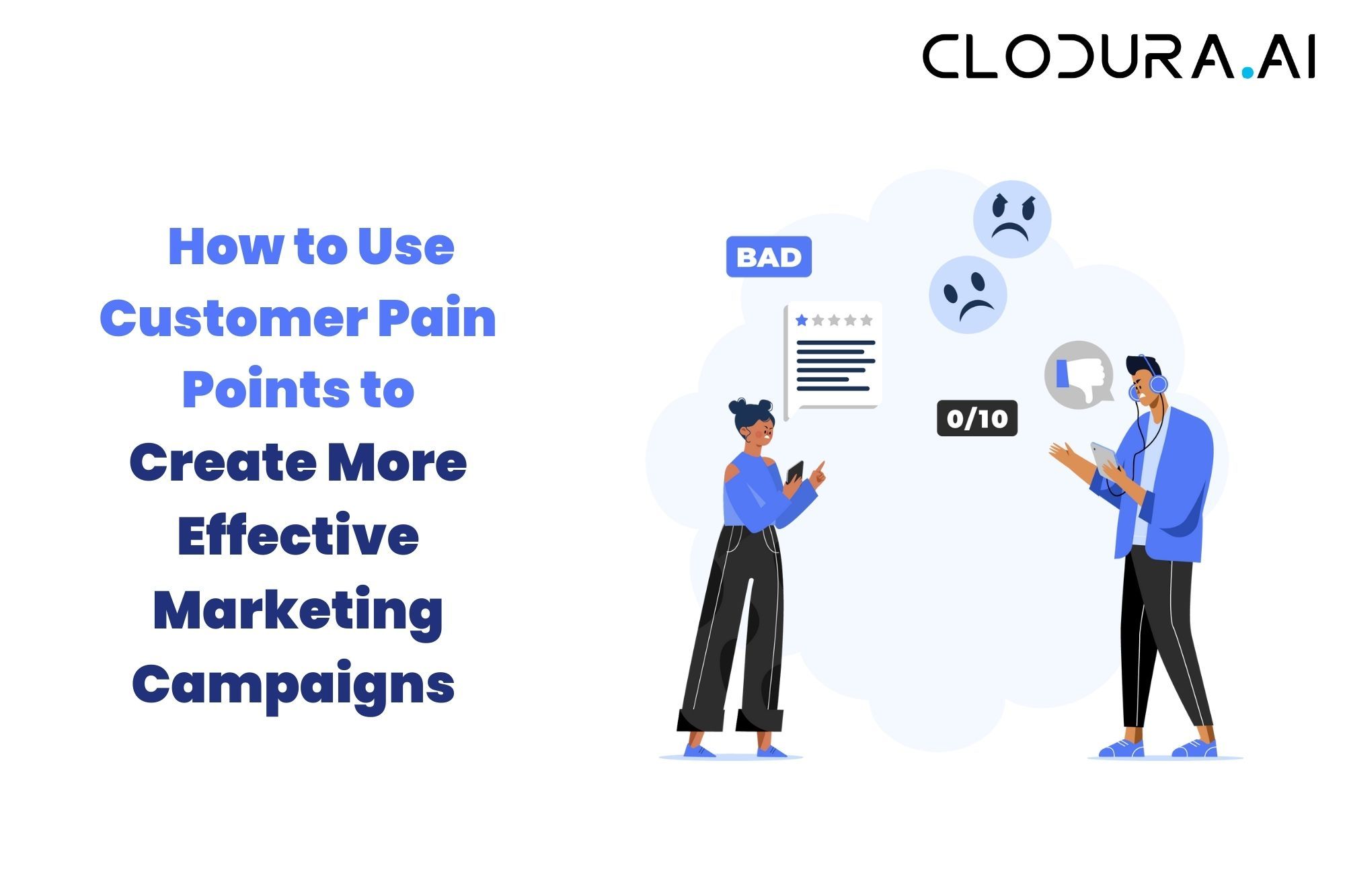Are you struggling to create marketing campaigns that truly resonate with your target audience?
If so, it's time to shift your focus to customer pain points. Understanding your customers' challenges and frustrations can be the key to crafting more effective and compelling marketing campaigns.
In this blog, we will explore how to use customer pain points to your advantage. By identifying the issues and problems that your target audience faces, you can tailor your marketing messages to address these pain points directly and provide solutions. By empathizing with your customers and acknowledging their pain points, you will create a stronger connection and build trust.
This, in turn, will increase the likelihood of conversions and customer loyalty. We will delve into various strategies and techniques for uncovering customer pain points, such as conducting thorough market research, analyzing customer feedback, and leveraging social listening tools. Additionally, we will discuss how to incorporate these pain points into your marketing campaigns for maximum impact. Don't miss out on this opportunity to take your marketing campaigns to the next level. Read on to discover how to harness the power of customer pain points and create more effective marketing campaigns.
Understanding customer pain points
To create more effective marketing campaigns, it's crucial to understand the concept of customer pain points. Pain points are the specific challenges and problems that your target audience faces. These can be anything from a lack of time, financial constraints, or the need for convenience.
When you understand your customers' pain points, you can develop marketing campaigns that directly address these issues. By offering solutions and highlighting the benefits of your products or services, you can position yourself as the answer to their problems.
Importance of identifying customer pain points in marketing
Identifying customer pain points is essential for marketing success. When you know what frustrates and challenges your customers, you can tailor your messaging to resonate with them on a deeper level. This allows you to create more personalized and targeted marketing campaigns that drive engagement and conversions.
By addressing pain points, you show your customers that you understand their needs and are committed to solving their problems. This builds trust and credibility, making it more likely that they will choose your brand over competitors.
How to identify customer pain points
To identify customer pain points, you need to conduct thorough market research. This involves analyzing data and gathering insights about your target audience. Here are a few strategies to help you uncover their pain points:
● Conduct surveys and interviews:
Reach out to your existing customers and ask them about their challenges and frustrations. This direct feedback can provide valuable insights into their pain points.
● Analyze customer feedback:
Look for patterns in customer reviews, comments, and complaints. These can indicate common pain points that you can address in your marketing campaigns.
● Leverage social listening tools:
Monitor social media platforms and online communities to understand what people are saying about your industry, products, and services. This can help you identify pain points that you may not have been aware of.
By combining these strategies, you can gain a comprehensive understanding of your customers' pain points and develop marketing campaigns that truly resonate with them.
The role of empathy in addressing customer pain points
Empathy plays a crucial role in addressing customer pain points effectively. When you empathize with your customers, you show that you understand and care about their challenges. This creates a stronger connection and builds trust, making it more likely that they will engage with your marketing campaigns.
To demonstrate empathy, put yourself in your customers' shoes and think about how their pain points affect their daily lives. Consider the emotions they may feel and the impact these challenges have on their overall well-being.
By acknowledging and validating their pain points, you show that you are genuinely committed to helping them find solutions. This empathy-driven approach will set you apart from competitors and create a more meaningful connection with your target audience.
Creating customer personas based on pain points
To create more effective marketing campaigns, it's helpful to develop customer personas based on pain points. A customer persona is a fictional representation of your ideal customer, including their demographics, preferences, and pain points.
By creating detailed customer personas, you can better understand the specific pain points your target audience faces. This allows you to tailor your marketing messages to resonate with their unique challenges and provide solutions that meet their needs.
When developing customer personas, consider factors such as age, gender, occupation, lifestyle, and values. Additionally, analyze the pain points you have identified through market research and incorporate them into your personas.
Incorporating pain points into your marketing messaging
Once you have identified the pain points of your target audience and created customer personas, it's time to incorporate these pain points into your marketing messaging.
Here are some strategies to consider:
● Highlight benefits and solutions:
Clearly communicate how your products or services can solve your customers' pain points. Focus on the benefits they will experience and the solutions you offer.
● Use relatable language:
Speak your customers' language by using words and phrases that resonate with them. Avoid jargon or technical terms that might alienate or confuse them.
● Showcase social proof:
Provide testimonials, case studies, and success stories that demonstrate how your brand has effectively addressed pain points for other customers. This social proof can build trust and credibility.
● Personalize your messaging:
Tailor your marketing messages to specific customer segments based on their pain points. By customizing your content, emails, and ads, you can create a more personalized experience that resonates with their specific challenges.
By incorporating pain points into your marketing messaging, you will create campaigns that are more relevant, engaging, and effective in driving conversions.

Using customer pain points to develop targeted marketing campaigns
Once you have a deep understanding of your customers' pain points, you can develop targeted marketing campaigns that address these challenges directly.
Here are some strategies to help you leverage customer pain points in your campaigns:
● Segment your audience:
Divide your target audience into smaller segments based on their pain points. This allows you to craft more personalized and targeted campaigns that resonate with their specific challenges.
● Create valuable content:
Develop blog articles, videos, and social media posts that provide valuable information and solutions to your customers' pain points. By offering useful content, you position yourself as a trusted resource and build credibility.
● Utilize storytelling:
Share stories that highlight how your brand has helped customers overcome their pain points. By weaving narratives into your marketing campaigns, you create an emotional connection and inspire action.
● Offer incentives:
Provide special offers, discounts, or free trials that directly address your customers' pain points. This encourages them to take action and try your products or services.
By aligning your marketing campaigns with your customers' pain points, you increase the likelihood of capturing their attention, driving engagement, and ultimately converting leads into loyal customers.
Measuring the effectiveness of your marketing campaigns based on customer pain points
To ensure the success of your marketing campaigns, it's essential to measure their effectiveness based on customer pain points. Here are some metrics to consider:
● Conversion rate:
Measure the percentage of website visitors or leads that convert into customers. This indicates how well your campaigns are addressing pain points and driving action.
● Engagement metrics:
Monitor metrics such as click-through rates, time spent on page, and social media engagement. These metrics provide insight into how well your campaigns resonate with your audience and capture their attention.
● Customer feedback:
Gather feedback from customers to understand how well your campaigns are addressing their pain points. This can be done through surveys, interviews, or monitoring online reviews.
By regularly measuring the effectiveness of your marketing campaigns, you can identify areas for improvement and make data-driven decisions to optimize your messaging and strategies.
Examples of successful marketing campaigns that address customer pain points
To further illustrate the power of using customer pain points in marketing campaigns, let's explore some successful examples:
1. Nike: Nike's "Just Do It" campaign addresses the pain point of lacking motivation and confidence. By showcasing athletes overcoming challenges and pushing their limits, Nike inspires customers to take action and believe in themselves.
2. Apple: Apple's "Shot on iPhone" campaign addresses the pain point of capturing high-quality photos. By showcasing stunning images taken with iPhones, Apple appeals to customers who value photography and want to capture memorable moments.
3. Dove: Dove's "Real Beauty" campaign addresses the pain point of low self-esteem and societal beauty standards. By celebrating diverse beauty and challenging traditional notions of beauty, Dove connects with customers on a deeper emotional level.
These examples demonstrate how effectively addressing customer pain points can result in powerful and memorable marketing campaigns.
To Wrapping Up,
Understanding and addressing customer pain points is the key to creating more effective marketing campaigns. By empathizing with your customers, identifying their pain points, and tailoring your messaging to address these challenges, you can build stronger connections, increase conversions, and foster customer loyalty.
Through thorough market research, customer feedback analysis, and social listening, you can uncover valuable insights into your target audience's pain points. By incorporating these pain points into your marketing messaging and developing targeted campaigns, you will create a more personalized and compelling experience for your customers.
Remember to measure the effectiveness of your campaigns based on customer pain points and make data-driven decisions to optimize your strategies. By continuously refining your messaging and addressing pain points, you will position your brand as the solution to your customers' challenges and drive long-term success in your marketing efforts.
Don't miss out on the opportunity to harness the power of customer pain points and take your marketing campaigns to the next level. Start implementing these strategies today and watch your engagement and conversions soar.
FAQs
Q. What are customer pain points?
Customer pain points are the problems, challenges, or frustrations that your customers face. They can be related to their personal or professional lives, and can be physical, emotional, or logistical.
Q. Why are customer pain points important for marketing?
Customer pain points are important for marketing because they allow you to create messages that resonate with your target audience. When you understand the problems that your customers are facing, you can position your product or service as the solution.
Q. How do I identify customer pain points?
Conduct surveys, analyze support tickets, and read customer reviews.
Q. How do I use customer pain points in my marketing campaigns?
Be specific and offer solutions in website copy, blog posts, social media, email, and paid ads.
Q. What are some examples of effective marketing campaigns that use customer pain points?
Dove's "Real Beauty Sketches", Head & Shoulders' "You're Not Alone", and Warby Parker's "Try 5 Frames for Free".


